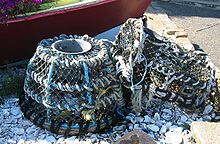Lobster trap
A long rope is attached to each trap, at the end of which is a plastic or styrofoam buoy that bears the owner's license number.New England fishermen in the United States used it for years before American companies introduced it to the Canadian fishery through their Atlantic coast canneries.[5] An 1899 report by the United States Fish Commission on the Lobster Fishery Of Maine, described the local "lath pots" used by Maine lobster fishers:[6] The framework of the bottom consists of three strips of wood, either hemlock, spruce, or pine (the first mentioned being the most durable), a little longer than the width of the pot, about 2¾ inches wide, and 1 inch thick.These hoops are made of branches of spruce or hemlock, or of hardwood saplings, such as maple, birch, or ash, generally retaining the bark.The openings into the pot ... are two in number, one at each end, are generally knit of coarse twine, and have a mesh between three-fourths of an inch and 1-inch square.
Lobster trap (disambiguation)Lobster-tailed potJerseylobsterscrayfishlobster fishingMaritimesstyrofoamHarlechYoughalSwampscott, MassachusettsCape CodNew EnglandUnited States Fish CommissionoverboardCrab trapKrusty KrabLobster hookProject GutenbergFishing tackleFish hookCircle hookHooksetSniggleFishing lineBraidedMonofilamentMultifilamentPower proSwivelFishing sinkerArlesey BombBombardaDownriggerSandsinkerFishing rodBamboo fly rodFishing reelFishing rod tapersFly rod buildingFishing baitBait fishBoiliesGroundbaitVermicompostWorm charmingPlastic baitDeadstickingPlastic wormFishing luresArtificial flyHeddonLittle CleoMormyshkaOriginal FloaterSabikiSpinnerbaitSpoon lureSpoonplugSurface lureSwimbaitTopwater lureZara SpookBite indicatorsFishing floatPellet wagglerShortfloatingQuiver tipFishing rigCarolina rigChod rigDrop shot rigHair rigTexas rigDiving maskHip bootPersonal flotation deviceWadersWetsuitFish stringerTackle boxFishing techniquesAma diversClam diggingFlounder trampingGathering seafood by handNoodlingPearl huntingScallop aquacultureTrout binningTrout ticklingBowfishingGiggingHarpoonHawaiian slingPolespearSpearfishingSpeargunTridentFishing linesAnglingDroplineDrum linesHandline fishingJiggerpoleJiggingJug fishingLongline fishingSpin fishingTip-upTrollingTrotlineFishing netsCast netCheena valaDrift netGhost netsGill netGlass floatsHaaf netHand netIce jiggerLampara netLampuki netLave netLift net